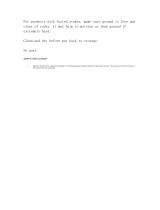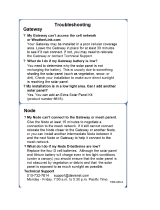
5.4.4 Automatic Binding Using the Menu Navigation ................................................................... 43
5.5 Setting the Maximum System Devices ........................................................................................44
5.6 Storage Mode and Sleep Mode ................................................................................................. 44
5.7 Modbus Communication Parameters ...........................................................................................44
5.7.1 Setting the Slave ID on a DX80 Gateway .......................................................................... 44
5.7.2 Setting the Baud Rate .................................................................................................... 45
5.7.3 Setting Parity ................................................................................................................45
5.8 Default Output Conditions ........................................................................................................ 45
5.8.1 Host Link Failure ............................................................................................................45
5.8.2 Gateway Link Failure ......................................................................................................46
5.8.3 Node Link Failure ...........................................................................................................47
5.9 Units Defined ..........................................................................................................................47
5.9.1 Interpreting Register Values in the Banner Wireless System ................................................ 49
5.10 Setting up the Wireless Network Using the Rotary Dials ..............................................................52
5.10.1 Rotary Dial Address Mode ............................................................................................. 52
5.10.2 Setting the Network ID Using the Rotary Dials ................................................................. 52
5.10.3 Setting the Device Address Using the Rotary Dials ............................................................53
5.10.4 Setting Up Channel Search Mode ................................................................................... 53
6 System Layouts ............................................................................................................ 55
6.1 Stand-Alone Systems ...............................................................................................................55
6.1.1 Mapped Pairs (DX70) ..................................................................................................... 55
6.1.2 Gateway with Multiple Nodes (DX80) ................................................................................56
6.1.3 Gateway Configured as a Modbus Master .......................................................................... 57
6.2 Modbus RTU ........................................................................................................................... 58
6.2.1 Modbus RTU Host Controlled Operation .............................................................................58
6.2.2 Modbus RTU with Multiple Slave Devices ...........................................................................59
6.2.3 Modbus RTU with Multiple Slave Devices - Layout 2 ............................................................60
6.3 Modbus/TCP and EtherNet/IP ....................................................................................................61
6.3.1 Host Connected - DX80 GatewayPro .................................................................................61
6.4 Data Radios ............................................................................................................................63
6.4.1 Data Radios ..................................................................................................................63
6.4.2 Data Radios with DX85 Modbus RTU Remote I/O Devices ....................................................63
6.4.3 Data Radios with a Gateway as the Modbus Master ............................................................ 64
7 Sensor Connections ...................................................................................................... 65
7.1 Discrete Inputs ...................................................................................................................... 65
7.1.1 Discrete Inputs, Sourcing ................................................................................................65
7.1.2 Discrete Inputs, Sinking ................................................................................................. 65
7.1.3 Discrete Inputs, MINI-BEAM ............................................................................................66
7.2 Discrete Outputs .................................................................................................................... 66
7.2.1 Discrete Outputs ............................................................................................................66
7.3 Analog Inputs ........................................................................................................................66
7.3.1 Analog Inputs, Powered using SureCross Device Terminals ..................................................66
7.3.2 Analog Inputs, Powered from Switch Power .......................................................................67
7.3.3 Analog Inputs, Powered Externally ...................................................................................67
7.3.4 Analog Inputs, Temperature Sensors ................................................................................67
7.3.5 Analog Inputs, QT50U Long-Range Ultrasonic Sensor ......................................................... 68
7.4 Analog Outputs ......................................................................................................................68
7.4.1 Analog Outputs, Three-Wire Sensors ................................................................................68
7.4.2 Analog Outputs, Drive Motor Controllers ........................................................................... 68
8 SureCross Power Solutions ...........................................................................................69
8.1 10 to 30V dc Power ................................................................................................................. 69
8.2 What is FlexPower
®
? ............................................................................................................... 69
8.2.1 Switch Power (with FlexPower) ........................................................................................69
8.2.2 FlexPower with Integrated Battery ................................................................................... 70
8.2.3 FlexPower
®
Solar Supply ................................................................................................70
8.3 Battery Life Calculations ...........................................................................................................70
8.3.1 Analog Configuration ......................................................................................................70
8.3.2 Discrete Configuration ....................................................................................................71
8.3.3 Temperature and Humidity Sensor ...................................................................................72
8.3.4 Calculating Battery Life ...................................................................................................73
8.4 Example Solar Powered Systems ...............................................................................................74
8.4.1 Parallel Solar Systems ....................................................................................................76
8.4.2 Battery Backup Feature ..................................................................................................76
8.4.3 Autonomous Process Monitoring with Continuous Sensor Operation ...................................... 76
8.4.4 Wireless Network Range Extension ...................................................................................77
9 Maintenance ................................................................................................................. 78
9.1 Replacing the Main Body Gasket ................................................................................................78
9.2 Replacing the Rotary Dial Access Cover ......................................................................................78
9.3 Battery Replacement ............................................................................................................... 78
9.3.1 Replacing the Battery (DX81 and DX81H Battery Supply Module) ........................................78
Contents
3






















